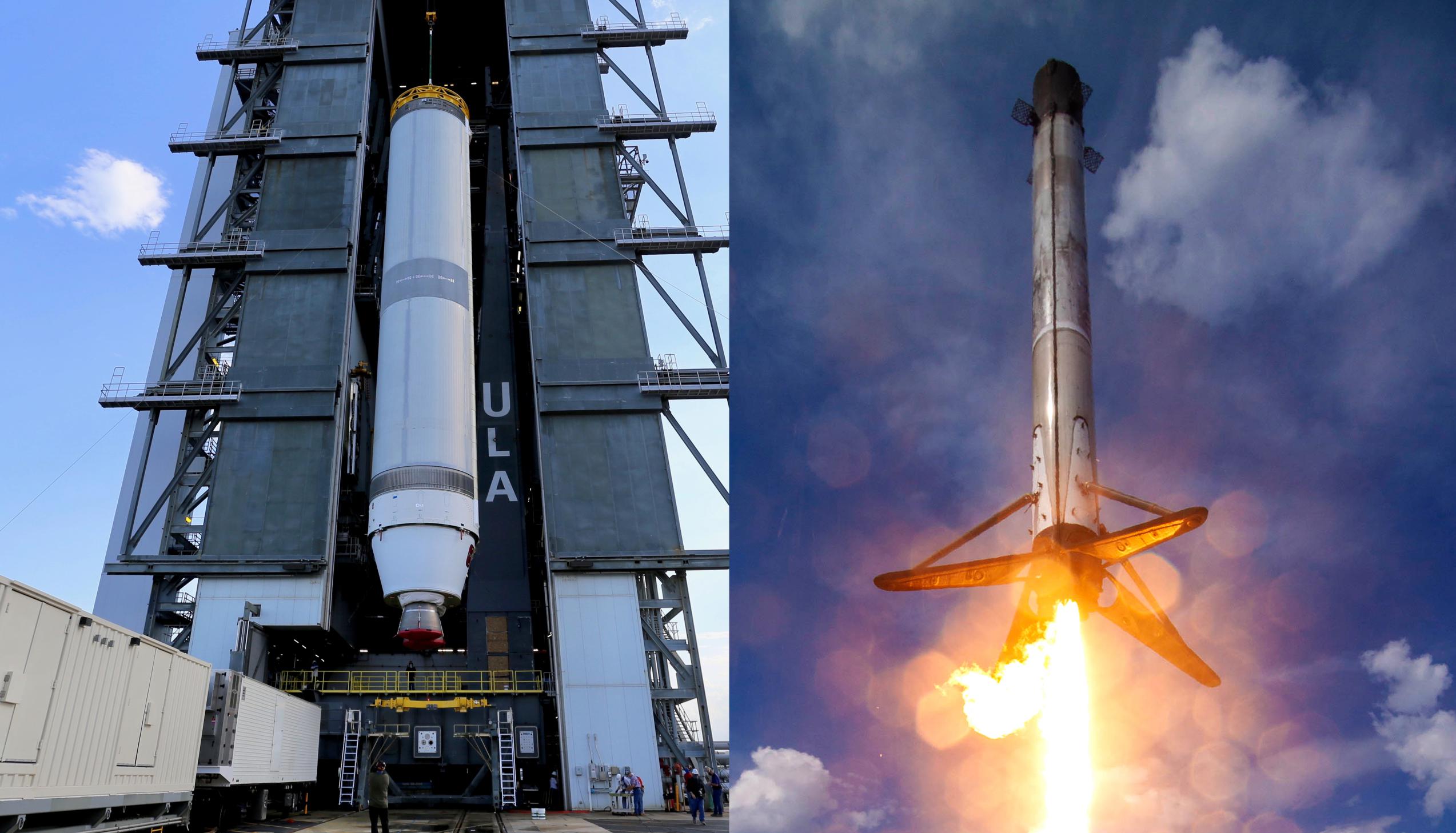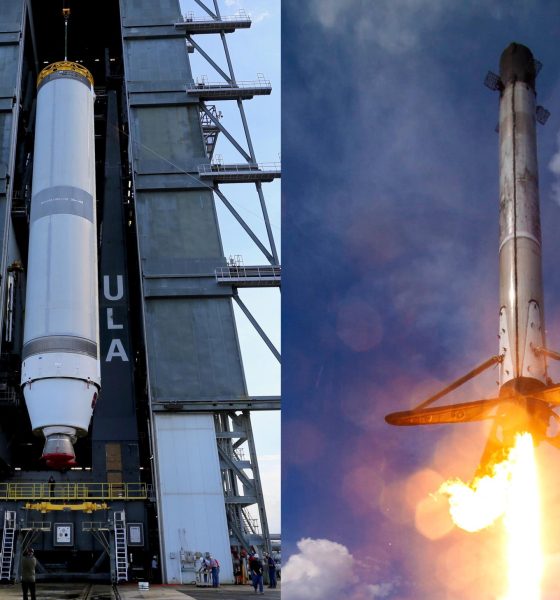

News
SpaceX, ULA awarded eight more US military launch contracts
The US military has awarded providers SpaceX and the United Launch Alliance (ULA) another eight launch contracts worth a total of $846 million that the companies will be tasked with completing over the next two or so years.
The US Space Systems Command (SSC) announced the decision on May 26th, providing some basic information about which missions were going to which provider. Per a highly unusual National Security Space Launch (NSSL) Phase 2 competition that ULA and SpaceX ultimately won in 2020, all major US military launches scheduled between 2020 and 2024 (at minimum) are to be split 60:40 between the companies, and this latest set of missions – more ‘funded’ than ‘awarded’ – are no different. Curiously, they also appear to indicate less of a cost cap than usual between SpaceX and its lone US competitor.
SpaceNews author Sandra Erwin has done an excellent job collating extra information about the eight launches rewarded. The latest batch continue a bizarre trend of the US military awarding complex, high-performance missions to ULA’s Vulcan Centaur, a rocket that has never flown and is unlikely to debut before 2023. Meanwhile, SpaceX’s Falcon 9 rocket, which is the most flown and most statistically reliable rocket currently in operation, continues to be used primarily for much simpler launches to lower orbits.
With this latest batch, ULA’s Vulcan Centaur rocket was assigned GPS III SV07 (headed to a medium Earth orbit); WGS-11, a geostationary military communications satellite; and USSF-16, USSF-23, and USSF-43, which are classified and unidentified. SpaceX’s Falcon 9 rocket was assigned USSF-124 (headed to low Earth orbit), USSF-62 (a military weather satellite headed to a polar orbit), and SDA Tranche 1 (a set of small communications satellites, some built by SpaceX, headed to a low polar orbit).
According to SpaceNews, ULA was awarded $566 million (~$113 million per launch) and SpaceX was awarded $280 million for its three contracts, meaning that SpaceX is charging an unusually high ~$93 million per Falcon 9 launch. Each of SpaceX’s three missions will almost certainly allow for Falcon 9 booster recovery, making the high cost even more odd.
Through its adherence to a bizarre 60:40 contract split that can only be described as an effort to ensure that ULA – possibly already predetermined to win before the competition began – would receive a lion’s share of contracts, has firmly hitched several near-term carts to a rocket that still hasn’t launched 22 months after its victory. Including a demonstration mission carrying a Moon lander and one or two NASA Cargo Resupply Services (CRS) missions carrying Sierra Nevada Corporation’s Dream Chaser space plane and cargo vehicle, Vulcan Centaur now has at least 11 launches – 10 for the US government – planned in 2023 and 2024.
Blue Origin, a company that has yet to deliver a single flightworthy BE-4 rocket engine to ULA, would need to deliver at least 22 engines over the next two or so years to avoid delaying Vulcan’s manifest. ULA’s existing rockets, Atlas V and Delta IV, each completed four launches in their first two years of service. SpaceX’s Falcon 9 was no different, launching four times in its first 2.5 years of operation. Only time will tell if Vulcan can more than double the early records of its closest rocket siblings.

Elon Musk
SpaceX issues statement on Starship V3 Booster 18 anomaly
The incident unfolded during gas-system pressure testing at the company’s Massey facility in Starbase, Texas.

SpaceX has issued an initial statement about Starship Booster 18’s anomaly early Friday. The incident unfolded during gas-system pressure testing at the company’s Massey facility in Starbase, Texas.
SpaceX’s initial comment
As per SpaceX in a post on its official account on social media platform X, Booster 18 was undergoing gas system pressure tests when the anomaly happened. Despite the nature of the incident, the company emphasized that no propellant was loaded, no engines were installed, and personnel were kept at a safe distance from the booster, resulting in zero injuries.
“Booster 18 suffered an anomaly during gas system pressure testing that we were conducting in advance of structural proof testing. No propellant was on the vehicle, and engines were not yet installed. The teams need time to investigate before we are confident of the cause. No one was injured as we maintain a safe distance for personnel during this type of testing. The site remains clear and we are working plans to safely reenter the site,” SpaceX wrote in its post on X.
Incident and aftermath
Livestream footage from LabPadre showed Booster 18’s lower half crumpling around the liquid oxygen tank area at approximately 4:04 a.m. CT. Subsequent images posted by on-site observers revealed extensive deformation across the booster’s lower structure. Needless to say, spaceflight observers have noted that Booster 18 would likely be a complete loss due to its anomaly.
Booster 18 had rolled out only a day earlier and was one of the first vehicles in the Starship V3 program. The V3 series incorporates structural reinforcements and reliability upgrades intended to prepare Starship for rapid-reuse testing and eventual tower-catch operations. Elon Musk has been optimistic about Starship V3, previously noting on X that the spacecraft might be able to complete initial missions to Mars.
Investor's Corner
Tesla analyst maintains $500 PT, says FSD drives better than humans now
The team also met with Tesla leaders for more than an hour to discuss autonomy, chip development, and upcoming deployment plans.

Tesla (NASDAQ:TSLA) received fresh support from Piper Sandler this week after analysts toured the Fremont Factory and tested the company’s latest Full Self-Driving software. The firm reaffirmed its $500 price target, stating that FSD V14 delivered a notably smooth robotaxi demonstration and may already perform at levels comparable to, if not better than, average human drivers.
The team also met with Tesla leaders for more than an hour to discuss autonomy, chip development, and upcoming deployment plans.
Analysts highlight autonomy progress
During more than 75 minutes of focused discussions, analysts reportedly focused on FSD v14’s updates. Piper Sandler’s team pointed to meaningful strides in perception, object handling, and overall ride smoothness during the robotaxi demo.
The visit also included discussions on updates to Tesla’s in-house chip initiatives, its Optimus program, and the growth of the company’s battery storage business. Analysts noted that Tesla continues refining cost structures and capital expenditure expectations, which are key elements in future margin recovery, as noted in a Yahoo Finance report.
Analyst Alexander Potter noted that “we think FSD is a truly impressive product that is (probably) already better at driving than the average American.” This conclusion was strengthened by what he described as a “flawless robotaxi ride to the hotel.”
Street targets diverge on TSLA
While Piper Sandler stands by its $500 target, it is not the highest estimate on the Street. Wedbush, for one, has a $600 per share price target for TSLA stock.
Other institutions have also weighed in on TSLA stock as of late. HSBC reiterated a Reduce rating with a $131 target, citing a gap between earnings fundamentals and the company’s market value. By contrast, TD Cowen maintained a Buy rating and a $509 target, pointing to strong autonomous driving demonstrations in Austin and the pace of software-driven improvements.
Stifel analysts also lifted their price target for Tesla to $508 per share over the company’s ongoing robotaxi and FSD programs.
Elon Musk
SpaceX Starship Version 3 booster crumples in early testing
Photos of the incident’s aftermath suggest that Booster 18 will likely be retired.

SpaceX’s new Starship first-stage booster, Booster 18, suffered major damage early Friday during its first round of testing in Starbase, Texas, just one day after rolling out of the factory.
Based on videos of the incident, the lower section of the rocket booster appeared to crumple during a pressurization test. Photos of the incident’s aftermath suggest that Booster 18 will likely be retired.
Booster test failure
SpaceX began structural and propellant-system verification tests on Booster 18 Thursday night at the Massey’s Test Site, only a few miles from Starbase’s production facilities, as noted in an Ars Technica report. At 4:04 a.m. CT on Friday, a livestream from LabPadre Space captured the booster’s lower half experiencing a sudden destructive event around its liquid oxygen tank section. Post-incident images, shared on X by @StarshipGazer, showed notable deformation in the booster’s lower structure.
Neither SpaceX nor Elon Musk had commented as of Friday morning, but the vehicle’s condition suggests it is likely a complete loss. This is quite unfortunate, as Booster 18 is already part of the Starship V3 program, which includes design fixes and upgrades intended to improve reliability. While SpaceX maintains a rather rapid Starship production line in Starbase, Booster 18 was generally expected to validate the improvements implemented in the V3 program.
Tight deadlines
SpaceX needs Starship boosters and upper stages to begin demonstrating rapid reuse, tower catches, and early operational Starlink missions over the next two years. More critically, NASA’s Artemis program depends on an on-orbit refueling test in the second half of 2026, a requirement for the vehicle’s expected crewed lunar landing around 2028.
While SpaceX is known for diagnosing failures quickly and returning to testing at unmatched speed, losing the newest-generation booster at the very start of its campaign highlights the immense challenge involved in scaling Starship into a reliable, high-cadence launch system. SpaceX, however, is known for getting things done quickly, so it would not be a surprise if the company manages to figure out what happened to Booster 18 in the near future.








